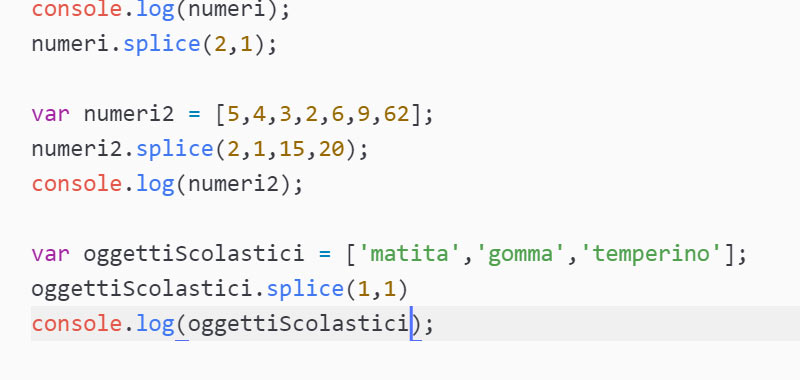
🌚 Add few items at the end of array: const arr = arr.splice(arr.length, 0, "🌕", "🌞", "🌦") // console. 🌚 You can specify 0 as the number of items to remove to simply add new items at the specified location in the array: const arr = arr.splice(2, 0, "⭐️", "💥") // console.log(myArr) // 🌚 Remove 1 element from index -2: const arr = arr.splice(-2, 1) // console.log(myArr) // 🌚 An arbitrary amount of additional arguments can be passed-in and will be added to the array: const arr = arr.splice(2, 1, "⭐️", "💥") // console.log(myArr) // 🌚 Remove 1 element at index 3: const arr = arr.splice(3, 1) // console.log(myArr) // 🌚 When only one argument is provided, all the items after the provided starting index are removed from the array: const arr = arr.splice(2) // console.log(myArr) // NOTE: Splice always returns an array containing the deleted elements. In item, The number you want to add( If you're removing, you can just leave this blank). In deleteCount, The number of items you want to remove. If start is negative, it will begin that many elements from the end of the array. If start is greater than the length of the array, then start will be set to the length of the array. Start specifies index at which to start changing the array. Syntax: let arrDeletedItems = array.splice(start]]]) const arr = arr.splice(2,3) // console.log(myArr) // Log the values that are commented out after the console.The splice method changes the content of the array in place and can be used to add or remove items from the array. Next: JavaScript sort() Method: Array Object Previous: JavaScript slice() Method: Array Object JavaScript Core objects, methods, properties. See the Pen array-splice-1 by w3resource ( on CodePen. Var newText5 = document.createTextNode("Removed fruits are: " + removed_fruits) ĭ(newParagraph5) Var newParagraph5 = document.createElement("p") Var newText4 = document.createTextNode("After replacing 1st and 2nd furits and adding 'Blackberry', 'Grapefruit', 'Guava', the new list is : " + fruitslist) ĭ(newParagraph4) Var newParagraph4 = document.createElement("p") Var removed_fruits = fruitslist.splice(0, 2,'Blackberry','Grapefruit','Guava') Var newText3 = document.createTextNode("Removed fruit is: " + remove_fruit) ĭ(newParagraph3) Var newParagraph3 = document.createElement("p") Var newText2 = document.createTextNode("After removing 4th fruit, the new list is : " + fruitslist) ĭ(newParagraph2) Var newParagraph2 = document.createElement("p") Var remove_fruit = fruitslist.splice(3, 1) Var newText1 = document.createTextNode("After adding 'Mango' in 3rd place : " + fruitslist) ĭ(newParagraph1)


Var newParagraph1 = document.createElement("p") Deletes elements from an array, optionally replacing them, to form another array. The splice method changes the content of the array in place and can be used to add or remove items from the array. Var remove = fruitslist.splice(2, 0, "Mango") Var newText = document.createTextNode("Fruits List : " + fruitslist) Var newParagraph = document.createElement("p")
.SPLICE JAVASCRIPT CODE
JS Code var fruitslist = new Array("Orange","Apple","Banana","Chery" ) In the following web document splice() method is used to reproduce the fruits order. If you don't specify any elements, splice simply removes elements from the array. In this case, you should specify at least one new element.Įlement1,element2.,elementN : The elements to add to the array. If removeCount is 0, no elements are removed. RemoveCount: An integer indicating the number of old array elements to remove. StartIndex: Index at which to start changing the array. Syntax splice(startIndex, removeCount, element1,element2., elementN) The splice() method is used to remove old elements and add new elements to an array.


 0 kommentar(er)
0 kommentar(er)
